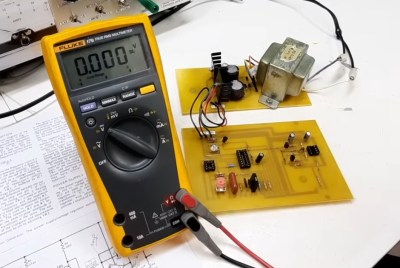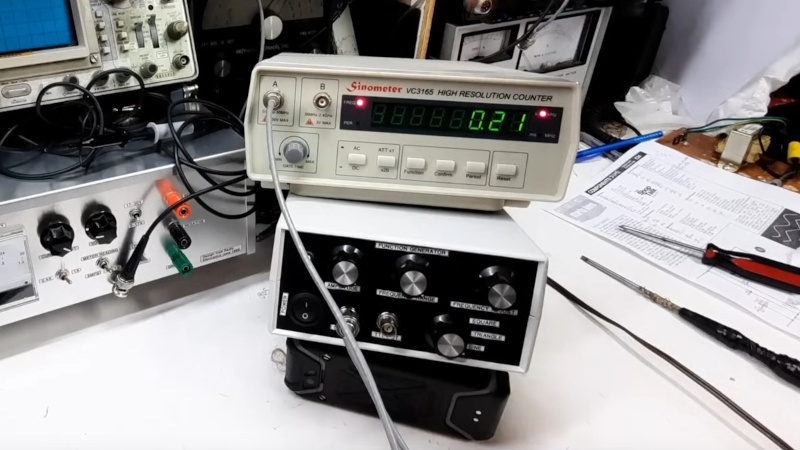It’s always a pleasure to find a hardware hacker who you haven’t seen before, and page back through their work. [Bettina Neumryr]’s niche comes in building projects from old electronics magazines, and her latest, a function generator from the British Everyday Electronics magazine in April 1983, is a typical build.
The project uses the XR2206 function generator chip, a favourite of the time. It contains a current controlled oscillator and waveform shaper, and can easily produce square, triangle, and sine waves. It was always a puzzle back in the day why this chip existed as surely the global market for function generators can’t have been that large, however a little bit of background reading for this write-up reveals that its intended application was for producing frequency-shift-keyed sinusoidal tones.

The EE project pairs the XR2206 with an op-amp current generator to control the frequency, and another op-amp as an amplifier and signal conditioner. The power supply is typical of the time too, a mains transformer, rectifier, and linear regulators. There are a pair of very period PCBs supplied as print-outs in the magazine for home etching. This she duly does, though with toner transfer which would have been unheard of in 1983. After a few issues with faulty pots and a miswired switch, she has a working function generator which she puts in a very period project box.
It’s interesting to look at this and muse on what’s changed in electronic construction at our level in the last four decades. The PCB is single sided and has that characteristic yellow of ferric chloride etching, it takes up several times the space achievable with the same parts on the professionally-made dual-sided board designed using a modern PCB CAD package we’d use today. A modern take on the same project would probably use a microcontroller and a DAC, and a small switch-mode supply for less money than that transformer would provide the power. But we like the 1983 approach, and we commend [Bettina] for taking it on. The full video is below the break.
















synthesizers use the same kind of chip as a vco.
The XR2206 was never used in a commercial synthesiser to my knowledge. There were some DIY designs, the best know being https://www.birthofasynth.com/Thomas_Henry/Pages/XR-VCO.html which managed 5 octaves of usable tracking.
I think Jameco (or somebody like that) sold this as a kit back in the day.
I have one somewhere in my pile ‘o stuff, I probably put it together int he late 80’s. I think it used these exact boards.
I kinda remember pulling it out for something about 5 years ago, and it still worked.
or MAX038 more powerfull
Yeah, I built my first function generator from the MAX038 datasheet. It was easy to understand how the chip was used, no programming necessary and single-sided through hole PCB was enough.
In some ways I miss the age of ordering weirdly custom ICs listed in paper catalogs.
This was one of a series of test gear. This and subsequent magazines available here: https://www.worldradiohistory.com/Everyday_Electronics.htm
There was a 6 digit frequency counter everybody built out of one of the Intersil parts, like the 7222 or something like that.
The thing did a blazing 5MHz or so
I made that back in 1988. the chip can also be designed into a circuit with modulating inputs and waveform offset voltages. the XR2206 was a very unique chip.
Awesome! It brings me back good memories from the time the electronics magazines were available in bookstores.
I built one from scratch back in the day. Never really worked too well, but did a lot of audio troubleshooting with it at a time when a store bought one was unobtainably expensive.
Man what a resource finding all of those old magazines. It’s nice to see some older projects done up in a simpler format that can be a little easier to understand. Especially when working with mixers and synths. I love to take some of these old projects and use the concepts and try to improve them with today’s technology with varying results. A lot of the old chips are no longer available, except for some retailers that have exorbitant prices. That’s if you get what you ordered at all.
Anyway, it’s a good read and a good look at some interesting projects from a bygone era. Some of the articles are a little humorous given their age, but it’s nice to see that someone has gone to the trouble to keep these interesting resources. And I found a few projects that I might build just as they are. The wife is going to kill me.